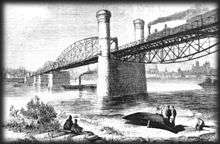Südbrücke, Mainz
The Südbrücke, Mainz (South bridge, the bridge has never been dedicated an official name, and is therefore referred to in different ways) is a railway bridge on the Main Railway that connects Mainz, Rhineland-Palatinate, across the Rhine with Gustavsburg in Hesse. It is one of the early railway bridges in Germany.
Südbrücke Mainz-Gustavsburger Eisenbahnbrücke | |
|---|---|
 The Gustavsburger Eisenbahnbrücke in May 2009 from the northeastern bank to the south west, direction Mainz. | |
| Coordinates | 49.991389°N 8.293889°E |
| Carries | Railways |
| Crosses | River Rhine |
| Locale | Rhineland-Palatinate |
| Official name | Südbrücke |
| Other name(s) | Eisenbahnbrücke, Gustavsburger Eisenbahnbrücke, Mainbahn-Rheinbrücke |
| Characteristics | |
| Design | Lenticular truss bridge (Pauli system) |
| Material | Iron |
| Total length | 1,028 m (1,124 yd) |
| Longest span | 2 x 106.6 m |
| Piers in water | Three |
| Clearance above | 9.1 m (10.0 yd) |
| History | |
| Designer | Heinrich Gottfried Gerber |
| Constructed by | MAN-Werk Gustavsburg |
| Construction start | 1860 (1868), 1910, 1948 |
| Construction end | 1862 (1871), 1912, 1949 |
| Collapsed | 1945 |

| |
History
Paulisystembridge (1862)

In the period between 1853 and 1859 railways were built by the Hessian Ludwig Railway on the left and right bank of the Rhine. Initially they were connected across the Rhine. As a result, a train ferry was established between Mainz and Gustavsburg, using two pontoons towed by paddle steamer to carry wagons across the Rhine. Passengers could use the steamer as a ferry from 1 August 1858.
In between 1860 and 1862, the south bridge was designed by the engineering works and iron foundry Maschinenfabrik und Eisengießerei J. F. Klett (later Maschinenfabrik Augsburg-Nürnberg - MAN) originating from Nuremberg.
Since the Roman bridge (Pons Ingeniosa) first built c. 30 AD [1] and the Carolingian Rhine bridge of Charlemagne,[2] it had been the first permanent bridge across the Rhine at Mainz, which until then had only a bridge of boats. It was after the Waldshut–Koblenz Rhine Bridge on the Upper Rhine, the cathedral Bridge in Cologne and the Kehl bridge the fourth railway bridge over the Rhine.
Design
The bridge was built according to the plans of Heinrich Gottfried Gerber, the Head of Bridge Division of Maschinenfabrik Klett. The puddled iron (wrought iron) structure bridge had four 105.2-metre-long (345 ft) bridge segments. The Pauli truss structure was arranged above the roadway, according to the Pauli lenticular truss bridge recently developed by Friedrich August von Pauli. Right of Rhine joined a long flood bridge with 28 other fields. [2] At both bridgeheads were they equipped with scheduled by district architect Ignaz victims man Gothic gates and bridge towers, which were to serve in time of war to defend the bridge.
| Wikimedia Commons has media related to Südbrücke (Mainz). |
Sources
- Bauer, Sibylle (2004), "Die älteste Steinbrücke am Rhein – stand sie in Mainz? Neuer Holzfund als Indiz für einen frührömischen Brückenschlag", Antike Welt, 35 (3), pp. 83–84
References and notes
- Bauer 2004, pp. 83f.
- Regesta Imperii RI I n. 477a: „The bridge erected near Mainz by order of Charlemagne is destroyed by fire; the plan to erect a stone bridge instead of a timber bridge was not accomplished. Ann. r. Franc. (Einh.), V. Karoli c. 17, 32 vgl. Poeta Saxo V, 457, Mon. Sangall. I, 30, Simson Karl d. Gr. 2,510.“; "Regest 477a". Regesta Imperii. Retrieved 2011-12-29.